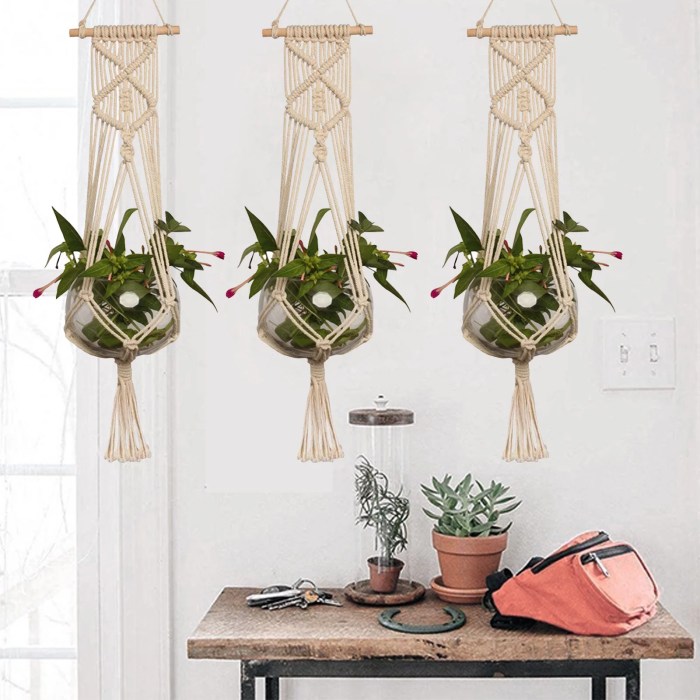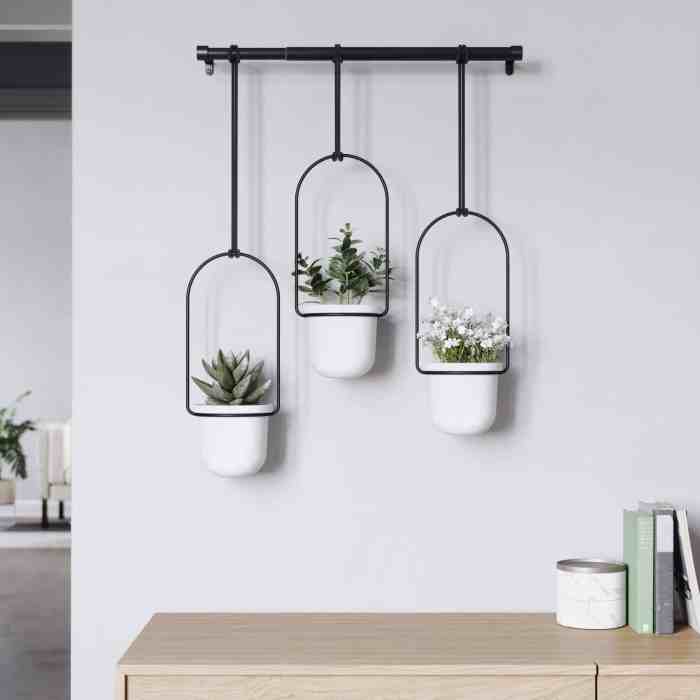Hanging plants for living rooms have become increasingly popular, offering a unique and stylish way to add a touch of nature to your home. With their cascading foliage and trailing vines, these plants can transform any living room into a lush and inviting oasis.
From the delicate maidenhair fern to the vibrant pothos, there are countless hanging plants to choose from, each with its own unique charm and benefits. Whether you’re looking to add a pop of color, purify the air, or simply create a more relaxing atmosphere, hanging plants are a versatile and effective solution.
Popular Hanging Plant Options

Hanging plants are a great way to add life and greenery to your living room. They can help to purify the air, and they can also create a sense of peace and tranquility. There are many different types of hanging plants to choose from, but some of the most popular options include:
Pothos (Epipremnum aureum) is a fast-growing vine that is known for its heart-shaped leaves. It is a very easy plant to care for, and it can tolerate a wide range of light conditions. Pothos is a great choice for beginners, and it can help to purify the air of toxins such as benzene and formaldehyde.
Spider plant (Chlorophytum comosum) is another popular hanging plant that is known for its long, thin leaves. Spider plants are very easy to care for, and they can tolerate a wide range of light conditions. They are also known for their ability to produce “spiderettes,” which are small plantlets that can be propagated to create new plants.
String of pearls (Senecio rowleyanus) is a unique hanging plant that is known for its long, trailing stems that are covered in small, pearl-shaped leaves. String of pearls is a relatively easy plant to care for, but it does require bright light and well-draining soil.
Burro’s tail (Sedum morganianum) is a succulent hanging plant that is known for its long, trailing stems that are covered in plump, fleshy leaves. Burro’s tail is a very easy plant to care for, and it can tolerate a wide range of light conditions.
It is also drought tolerant, making it a great choice for those who forget to water their plants.
Plant Care Considerations
Hanging plants bring a touch of greenery and life to any living room, but they require specific care to thrive. Understanding their watering, lighting, humidity, and fertilization needs is crucial for maintaining healthy and vibrant plants.
Hanging plants are a beautiful and easy way to add life to your living room. They can purify the air, add a touch of greenery, and create a sense of peace and tranquility. If you’re looking for a way to add some personality to your living room, hanging plants are a great option.
And with the right hanging plant hangers indoor , you can create a unique and stylish display that will be the envy of your friends.
Watering
Hanging plants tend to dry out faster than their counterparts on the ground due to increased air circulation. Check the soil regularly and water when the top inch feels dry to the touch. Avoid overwatering, as it can lead to root rot.
Lighting
Most hanging plants prefer bright, indirect light. Avoid placing them in direct sunlight, as it can scorch their leaves. Consider using sheer curtains or blinds to filter the light if necessary.
Humidity
Many hanging plants, such as ferns and air plants, thrive in humid environments. Misting the plants regularly or placing them on a pebble tray filled with water can help increase humidity.
Fertilization, Hanging plants for living room
Hanging plants benefit from regular fertilization during the growing season. Use a balanced liquid fertilizer diluted to half strength and apply it every two to four weeks.
Hanging plants can be a great way to add life to your living room. They can also help to purify the air and create a more relaxing atmosphere. If you’re looking for a way to add some greenery to your home, consider starting an indoor hanging vegetable garden . Hanging vegetable gardens are a great way to grow your own food, and they can also be a beautiful addition to your home.
You can grow a variety of vegetables in hanging planters, including tomatoes, peppers, herbs, and strawberries. With a little care and attention, you can enjoy fresh, homegrown vegetables all year round.
Aesthetic Considerations
Hanging plants are a stylish and practical way to elevate the aesthetics of a living room. They add a touch of greenery and freshness, creating a more inviting and welcoming atmosphere. By incorporating hanging plants into your decor, you can enhance the overall ambiance of the space and make it more visually appealing.
When choosing hanging plants for your living room, consider the style of your decor. For a modern or contemporary look, opt for plants with clean lines and simple shapes, such as succulents or air plants. For a more traditional or bohemian style, choose plants with flowing leaves or trailing vines, such as ivy or ferns.
Plant Placement and Arrangement
The placement and arrangement of your hanging plants can also have a significant impact on the overall aesthetics of the room. Consider the following tips:
- Hang plants at different heights to create a more dynamic and visually interesting display.
- Group plants together in clusters to create a focal point or to fill a large space.
- Use hanging plants to draw attention to a specific area of the room, such as a fireplace or a reading nook.
- Consider the natural light in the room when placing your plants. Some plants require more light than others, so be sure to choose plants that are well-suited to the light conditions in your living room.
Design Ideas and Inspiration
Hanging plants can transform a living room into a vibrant and inviting space. From cascading greenery to trailing vines, there are endless possibilities for creating stunning displays.
Hanging plants for living room not only enhance the aesthetics but also provide a touch of nature indoors. If you’re looking for a practical and stylish way to incorporate greenery, consider a wall hanging herb garden indoor . These vertical gardens are perfect for growing fresh herbs in limited spaces, adding a touch of culinary flair to your living room.
From lush ferns to cascading vines, hanging plants bring life and character to any living space.
One popular design idea is to suspend plants from the ceiling. This creates a dramatic effect, drawing the eye upward and adding height to the room. Alternatively, plants can be hung from shelves, walls, or even picture frames for a more eclectic look.
Creative Arrangements
To create a lush and cohesive display, consider grouping plants of different sizes, shapes, and textures. For instance, pair a trailing pothos with a bushy fern and a sculptural succulent. Experiment with different hanging heights to add depth and interest.
Focal Points
Hanging plants can be used to create focal points in a living room. A large, statement-making plant, such as a Monstera deliciosa, can instantly become the center of attention. Alternatively, a cluster of smaller plants can be arranged to create a more subtle but equally eye-catching display.
Ambiance
The type of hanging plants you choose can influence the ambiance of your living room. Air plants, with their delicate and ethereal appearance, can create a sense of tranquility. Conversely, trailing plants like ivy or philodendron can add a touch of whimsy and movement to the space.
DIY Projects and Hacks
Creating custom hanging plant displays doesn’t have to be expensive or time-consuming. With a few simple materials and a bit of creativity, you can easily DIY your own unique plant hangers.
Here are a few easy and affordable DIY projects to get you started:
Macrame Plant Hangers
Macrame plant hangers are a popular and stylish way to display your plants. They’re relatively easy to make, and you can customize them to any length or style.
To make a macrame plant hanger, you’ll need:
- Macrame cord
- Scissors
- A measuring tape or ruler
- A hook or ring to hang the plant hanger from
Once you have your materials, you can follow these step-by-step instructions to make your own macrame plant hanger:
- Cut four pieces of macrame cord, each about 6 feet long.
- Fold the cords in half and tie a knot at the top.
- Divide the cords into two groups of two, and tie a knot in each group about 6 inches from the top knot.
- Take one cord from each group and tie a knot in the center. Repeat this step with the other two cords.
- Continue tying knots in the center of the cords, alternating between the two groups, until the hanger is the desired length.
- Tie a knot at the bottom of the hanger and trim any excess cord.
- Hang your plant hanger from a hook or ring and enjoy!
Ultimate Conclusion: Hanging Plants For Living Room

Incorporating hanging plants into your living room decor is not only aesthetically pleasing but also beneficial for your well-being. By choosing the right plants and providing them with proper care, you can enjoy the beauty and benefits of nature right in your own home.
Popular Questions
How often should I water my hanging plants?
Watering frequency depends on the type of plant and the humidity level in your home. As a general rule, water your plants when the top inch of soil feels dry to the touch.
What is the best light for hanging plants?
Most hanging plants prefer bright, indirect light. Avoid placing them in direct sunlight, as this can scorch their leaves.
How can I create a hanging plant display?
There are many ways to create a hanging plant display. You can use macrame hangers, wire baskets, or even repurposed items like old jars or cans.